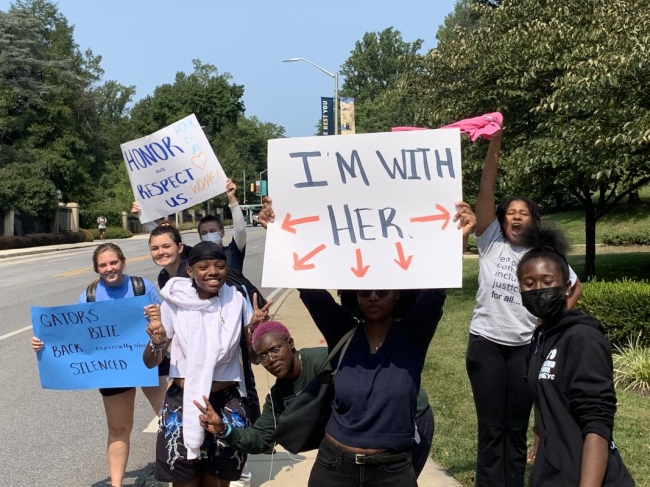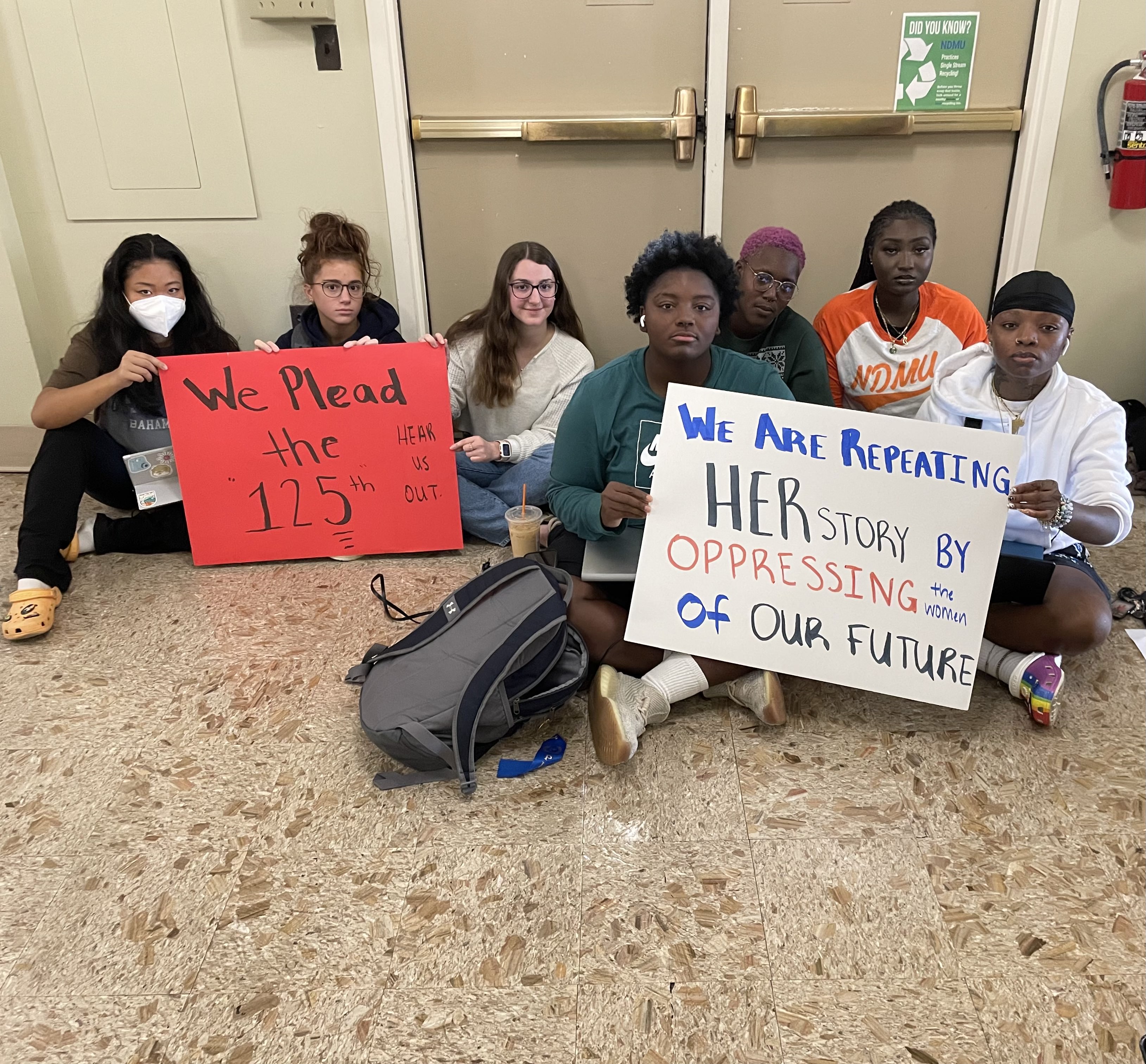You have /5 articles left.
Sign up for a free account or log in.

Notre Dame of Maryland University students protest the college’s decision to switch to coeducation. Students and alumnae were blindsided by the announcement last week, and many say the move strips the university of its core mission and identity.
Alexandra Malinowski
One hundred and twenty-five years after its founding as the first Catholic university in the U.S. to grant four-year degrees to women, Notre Dame of Maryland University is going coed—much to the chagrin of many students and alumnae.
The only remaining women’s college in Maryland announced last Tuesday that it will begin enrolling undergraduate men in fall 2023. The decision was made at the recommendation of an enrollment task force assembled last year by the university’s Board of Trustees, which examined falling enrollment rates at women’s colleges across the country. NDMU’s own undergraduate enrollment has fallen significantly in recent years, from 1,169 in fall 2014 to 807 in fall 2021.
“The Board recognized that in order for NDMU to flourish for years to come, we needed to expand our mission,” Board of Trustees chair Patricia McLaughlin wrote in a statement.
Many current students and alumnae argue that by becoming a coeducational institution, the university is not expanding its mission but abandoning it. Each one who spoke to Inside Higher Ed said the shift would fundamentally alter the NDMU experience and that they were blindsided by the decision, which was made behind closed doors. (Note: This paragraph has been updated to include a link to NDMU's stated mission. This article has been updated from an earlier version to correct several errors of fact and interpretation.)
“The decision was made entirely by the Board of Trustees, with no input from students, staff, faculty, or alumni,” said Alex Malinowski, a current senior at NDMU. “It’s truly heartbreaking. We feel incredibly disrespected.”
Next fall won’t be the first time the Baltimore institution has admitted men: NDMU’s College of Adult Undergraduate Studies—which started as a Weekend College in 1975—has always been coeducational, as has the graduate program, which launched in 1984. But Christine Baumgarten, an alumna who also worked in the university’s office of enrollment until 2015, said there’s a difference between having men on campus and eschewing the identity of a women’s undergraduate college. (Due to an editing error, this paragraph previously misidentified NDMU's coeducational program.)
“Women’s colleges are wholly unique experiences,” she said. “At the undergraduate level, particularly when you have students coming out of high school doing their core identity-forming, it is so empowering for women to have a space in a classroom where they don’t feel judged, where they can feel heard and be engaged as women growing into professionals.”
A spokesperson for NDMU pointed to a formal statement and an FAQ page, both released Tuesday after the announcement. (This paragraph has been updated to include a link to the statement.)
The university’s switch to coeducation makes it the latest in a long line of women’s colleges that have either opened up to men or shuttered their doors.
Emerald Archer, the executive director of the Women’s College Coalition, of which NDMU is a member, said many women’s colleges are facing a “perfect storm” of enrollment and financial woes that have forced them into a corner.
“Women’s colleges are having to make some really hard decisions … but I’m confident that leadership for our schools are exhausting every option before closing or going coed,” she said. “These decisions are not made lightly.”
A ‘Mission-Altering Decision’
Students at NDMU got the news that their school was going coed through a letter that arrived in their email inboxes without warning Tuesday afternoon. (This paragraph has been updated to clarify the way the students received the news.)
Malinowski, who was in the dining hall when the email came through, said that when students realized what it meant, “chaos ensued.”
“People were shouting, upset, crying,” she said. “It was just truly an astounding moment for the school to shred its history so quickly and without warning.”
Alumnae and faculty were similarly thrown by the announcement. Nancy Tarr Hart, an alumna of NDMU’s adult college, said she “found her voice” at NDMU, and she credits her experience at a women’s college with helping her jump-start a second act in her life. Years after graduating, she was asked to return and teach philosophy, later becoming the department chair—a position she held until her retirement in May. She said she was “shocked and angered” by NDMU’s decision.
“It felt like I was punched in the gut,” she said. “Honestly, I felt betrayed.”
Students and alumnae say the lack of transparency around the board’s decision made the news all the more upsetting, and the university handled the rollout poorly, without acknowledging the magnitude of the transition.
“It’s a massive, sweeping change, a mission-altering decision, and yet not a single person outside of the board and administrators knew this was even being considered before the press release,” said Baumgarten. “It’s becoming a case study in how not to do institutional change.”
Dozens of alumnae voiced their opposition to the move in a meeting with NDMU president Marylou Yam held over Zoom Thursday night. On alumnae Facebook groups and other social media sites, many expressed anger mixed with nostalgic remembrances of what they described as the distinct, community-centered experience of attending a women’s college.
 Students are organizing to express their disapproval. At an on-campus information session Thursday, more than 50 current students walked in with tape over their mouths. Malinowski, who helped organize the protest, said the move was symbolic of the university “shutting out” students from the decision-making process.
Students are organizing to express their disapproval. At an on-campus information session Thursday, more than 50 current students walked in with tape over their mouths. Malinowski, who helped organize the protest, said the move was symbolic of the university “shutting out” students from the decision-making process.
“It’s just really unfair that the Board of Trustees made this decision before asking for anyone’s advice or how we felt about it,” said Narelle Hernandez, another NDMU senior.
On Friday, dozens of students gathered outside Yam’s office throughout the day for a silent sit-in. Malinowski said it would be overly optimistic to think student action could reverse the university’s decision, but that it was important to her and her peers to vocalize their discontent.
“Our goal is for the president and Board of Trustees to know they overlooked Notre Dame women, a powerful force on campus that are unhappy with the decision,” she said. “We will continue to fight for the college to remain a women’s college, but right now our primary goal is to make sure everyone’s voice is heard.”
Tarr Hart said she thought there were a number of alternative options to boost enrollment that didn’t involve “abandoning the mission” of NDMU. The fallout from going coed, she believes, will only make the university’s struggles more acute.
“I honestly think they’re going to lose current students, potential students and donors,” she said, adding that she was unlikely to make any more donations to her alma mater.
Malinowski concurred. She said that if she weren’t graduating next fall, she would consider transferring, and that many of her younger peers have been mulling over whether to stay.
Hernandez said she chose NDMU because of its historic mission as a women’s college. While she will graduate before any men are enrolled, she worries that underclasswomen and prospective students will be “robbed of the experience” that she credits with helping her find her voice and come into her own.
“Since it’s an all-women’s college, women who are introverts gain the strength to be able to speak up more in class so that they can get out of their shell,” Hernandez said. “Once they introduce men into classes, that’s going to be harder.”
Eric Bryan, vice president of enrollment strategies for the Parish Group, which focuses on higher education marketing, has worked with many small colleges—including women’s colleges. He said that in his experience, women’s colleges don’t turn to a coed transition unless all other enrollment-boosting options have been exhausted. Bryan also questioned the wisdom of relying on men to boost enrollment, as men accounted for 71 percent of the overall college enrollment decline over the past five years, according to data from the National Student Clearinghouse; as of spring 2021 almost 60 percent of all college students were women, a record high.
“In a lot of these cases, it really is a last-ditch effort where they don’t see another path forward,” he said. “Otherwise, why would you risk alienating 100-plus years of alumnae?”
But Baumgarten, Tarr Hart and others said NDMU’s secretive decision-making process and surprise announcement didn’t give the university community a chance to devise alternative solutions or fundraise their way out of the problem, like supporters of Sweet Briar College did when the Virginia women’s college seemed on the brink of closure in 2014.
Baumgarten added that while the news came as a shock, she knew there was always a chance that NDMU would go the way of other struggling women’s colleges, including the College of New Rochelle in New York and the University of St. Joseph in Connecticut. She’s been a member of the Facebook group NDMU Alumnae Against Co-education in the Women’s College since 2018.
“Every women’s college knows somewhere in the back of their head that they’re one administration away from a decision like this,” she said. “You have to be constantly vigilant.”
Women’s Colleges ‘Running Out of Runway’
A little over 50 years ago, there were 230 women’s colleges in the U.S., according to a 2014 report from the Women’s College Coalition. After NDMU transitions to undergraduate coeducation, there will be just 33, a decrease of 86 percent.
Some, like Converse University in South Carolina, have gone the route of NDMU and transitioned to coeducation. Others, like Judson College in Alabama, simply closed up shop.
Bryan said that when the going gets rough, women’s colleges should look to distinguish themselves through their unique identities rather than abandon them. It might be more difficult—and potentially more expensive— than simply “letting in the other half of the population,” Bryan said, but it’s likely worth it in the long run. He noted that that seems to be especially true for NDMU, which is surrounded by other coed Catholic universities in Baltimore—including Loyola University Maryland, with which NDMU shares a library.
“One of the first things I tell colleges struggling with enrollment is, ‘You need a way to define the difference of your institution,’” he said. “If you’ve already got one built in, why would you abandon that?”
The enrollment woes women’s colleges face are not evenly distributed. Fewer than 2 percent of female undergraduates in the U.S. enroll in private, nonprofit women’s colleges and universities every year, according to WCC data; of those, more than half attend just nine colleges.
Archer of the WCC fears that the more elite women’s colleges—such as the Seven Sisters, a group of the nation’s oldest all-women institutions, including Smith and Wellesley Colleges—may be all that’s left of the sector if current trends continue. She said that if smaller women’s colleges like NDMU are lost or go coed, a subset of the population that these women’s colleges serve—namely, young women from disadvantaged backgrounds—will be the ones who miss out on a quality education. According to a WCC report from 2014, 94 percent of women’s college students receive financial aid, and 48 percent are Pell Grant recipients.
“NDMU is a bat signal to show that women’s colleges need federal support, and they need it now,” Archer said. “We’ve sounded the alarm, but there is this trickle of press releases where colleges are having to make hard decisions, and we’re running out of runway.”
Baumgarten said the rate at which women’s colleges are disappearing makes it hard to imagine future generations enjoying the same range of institutional choice that she had when applying in the late 2000s.
“I’ve joked with my husband that if we ever have a daughter, I would take her to every single woman’s college, because I would really want her to see the difference in what that type of environment does,” she said. “At this point, it’s going to be a very short road trip.”





